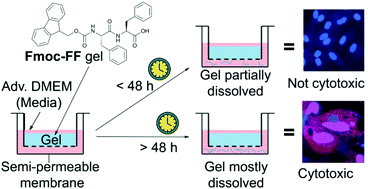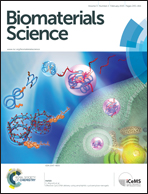Dissolution and degradation of Fmoc-diphenylalanine self-assembled gels results in necrosis at high concentrations in vitro†
Abstract
Herein we report an approach to assess in vitro cellular responses to the dissolution or degradation products from Fmoc-diphenylalanine (Fmoc-FF) self-assembled hydrogels. Three cell lines were used in these studies and two-way ANOVA was used to assess (i) the age of gel dissolution and degradation products and (ii) exposure time on cell fate and state, using viability assays in conjunction with time-lapse fluorescence and high-resolution scanning electron microscopy investigation. The studies show that leaching time but not the exposure time affects the overall cell viability. The cytotoxic effect was only observed once the gel is completely dissolved. Further analysis revealed that the principal mechanism of cell death is necrosis. In addition, the effect of chemotherapeutics (5-fluorouracil and paclitaxel) released from the Fmoc-FF gel (with addition before and after gelation) on colorectal cancer cells were investigated using this methodology, demonstrating enhanced activity of these drugs compared to bulk control. This enhanced activity, however, appears to be a combination of the apoptosis caused by the cancer drugs and necrosis caused by gel dissolution and degradation products. Given that in vivo studies by others on Fmoc-peptides that this material is not harmful to animals, our work highlights that conventional in vitro cellular assays may yield conflicting messages when used for the evaluation of cytotoxicity and drug release from self-assembled gels such as Fmoc-FF and that better in vitro models, (e.g. 3D cell culture systems) need to be developed to evaluate these materials for biomedical applications.


 Please wait while we load your content...
Please wait while we load your content...